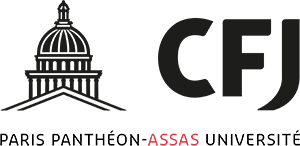Course catalogue and ECTS credits
Degree in journalism (*)
Work load and allotment of ECTS credits
The CFJ’s degree in journalism is awarded to students who have completed two years (4 semesters) of study, during which they cumulate 1500 hours of work per year as part of lectures, hands-on experience; internships and personal projects (please see ‘work load’ below).
Students’ work is evaluated according to four criteria:
- participation
- results in relation to expectations
- progress
- whether professional and ethical rules have been respected
At the CFJ, we use the European Credit Transfer System (ECTS). It allocates 30 ECTS credits for each of the 4 semesters, making a total of 120 ECTS credits at the end of two years of study (please see ‘allotment of credits’ below).
Evaluation methods are detailed in the school regulations distributed to each student at enrolment.
2-year degree programme
First year
First semester
| Classes | ECTS |
| Unit 1 – Basic journalism techniques | 20 |
| – Agencies | 2 |
| – Basic writing techniques | 9 |
| – School-produced newspaper |
5 |
| – Editorial procedures / typology | 1 |
| – Introduction to using a newsroom | 3 |
| Unit 2 – Introduction to audio-visual media | 6 |
| – Basic sound production | 3 |
| – Basic video production | 3 |
| Unit 3 – Sources and ethics | 4 |
| – Sources | 2 |
| – Ethics and codes of conduct | 1 |
| – International media channels – Modern languages (English) | 1 |
| TOTAL | 30 |
Second semester
| Classes | ECTS |
| Unit 1 – Multimedia reporting | 16 |
| – Web videos | 2 |
| – Data | 2 |
| – Photography | 1 |
| – Computer coding and web design | 1 |
| – Further newsroom techniques | 3 |
| – Reporting | 7 |
| Unit 2 – Investigative journalism | 8 |
| – Leading an investigation | 7 |
| – Ethics and codes of conduct | 1 |
| Unit 3 – Further audio-visual techniques | 6 |
| – Advanced television techniques | 3 |
| – Advanced radio techniques | 3 |
| TOTAL | 30 |
Second year
Third semester
| Classes | ECTS |
| Unit 1 – Media major 1 | 13 |
| Unit 2 – Media minor | 4 |
| Unit 3 – Professional know-how | 4 |
| Unit 4 – English | 1 |
| Unit 5 – Internship at a regional daily newspaper | 8 |
| TOTAL | 30 |
Fourth semester
| Classes | ECTS |
| Unit 1 – Media major 2 | 14 |
| Unit 2 – Minor project | 4 |
| Unit 3 – Presentation to a teaching committee | 2 |
| Unit 4 – Internship in a specialized field | 10 |
| TOTAL | 30 |
(*) Programme and ECTS credits for 2019 classes
How ECTS credits are granted
Evaluation
Teachers evaluate students or apprentices on every exercise or individual project they complete throughout the year according to the principles of continuous assessment. They establish a final evaluation once each module is completed. All teaching units (classes, seminars, research projects, internships) receive a letter grade from A to E, which evaluates the quality of the students’ work and of their participation. At the end of each semester, a committee of teachers awards a grade for each of the semester’s course units.
| Letter grade | Grade out of 20 |
Meaning |
| A+ | 20 | Course work: The exercise requires superficial or no correction and fully meets with requirements. It is of print-worthy quality.
Internship: The student has already acquired the level of skills expected of a young professional and can carry out their work autonomously. |
| A | 18 – 19 | |
| B+ | 16 – 17 | Course work: Very good work, with room for further improvement.
Internship: The student has already acquired most of the skills expected of a young professional and carries out most of their work autonomously. They have mastered the basics, but require further practice. |
| B | 14 – 15 | |
| C+ | 12 – 13 | Course work: Good work, but which requires a certain amount of correction to make it print-worthy.
Internship: The student has successfully completed most of their tasks but still needs help with some of them, either all or part of the time. The work they carried out failed to demonstrate that they have acquired basic skills and/or their personal investment is insufficient. |
| C | 10 – 11 | |
| D+ | 8 – 9 | Course work: Insufficient work which needs to be almost entirely redone.
Internship:The student requires considerable help to complete the tasks entrusted to them. Their work shows that they do not understand – even theoretically – the basics of their profession and/or their personal investment is insufficient. |
| D | 6 – 7 | |
| E+ | 4 – 5 | Course work: Work is poorly carried out and demonstrates serious shortcomings.
Internship: The student is unable to complete the tasks attributed to them, even with help, since they lack any understanding of theoretical basics and/or their personal investment is insufficient. |
| E | 0 – 3 |
Conversion into ECTS credits
If the student has completed their work to a highly satisfactory level (A or B), they validate their ECTS credits. If their work is of a satisfactory level (C), they may also earn credits unless the committee of teachers decides otherwise.
If their work has not been completed successfully (D or E), their credits are suspended. They must then complete a probationary assignment in order to validate these points. If this assignment is not completed, no credits may be earned.
How the ECTS system works
This system is a tool used by the EHEA (European Higher Education Area). It aims to make study programmes easier to interpret and thus improve the quality of higher education. The goal of the ECTS system is to facilitate the scheduling, implementation and evaluation of domestic and study abroad programmes through the official recognition of students’ results, diplomas and study periods. In 1999, The Bologna Declaration included the ECTS system as one of the main goals to attain for all of the countries participating in the Bologna Process. Thanks to the reforms the Process ushered in, the ECTS system has become a key tool in the European Higher Education Area (EHEA).
ECTS credits express learning quantitively, based on specific results and their associated work load. 60 ECTS credits correspond to the results and the work load associated with a year of full-time university level study (or equivalent), usually made up of a certain number of teaching units or modules linked to credits which correspond to students’ results and work load.
- Learning results are what a student knows, understands and is able to do once they have completed a teaching unit. They must be evaluated according to procedures which call on clear and easy to interpret criteria.
- Work load is an estimate of the time a student generally needs to complete to a satisfactory level all learning activities such as their classes, seminars, projects, practical exercises, internships and the personal study required to acquire the learning results.
définis. In most cases, one year at university represents between 1 500 and 1 800 hours of work, which means that one credit corresponds to between 25 and 30 hours of work. This is considered a usual work load and it should be noted that the amount of work necessary to acquire the expected learning results varies from student to student. - The allotment of ECTS credits is the process of assigning a certain number of credits to certificates, degree programmes or teaching units, such as classes, dissertations, professional training and internships.
- Granting ECTS credits means formally allocating to students and other learners the credits which correspond to their study certificate and/or its teaching units, if they have obtained the expected learning results. National authorities must designate the schools which have the right to dispense ECTS credits. Credits are granted once students have completed the required learning activities and attained the expected results.
- Credit accumulation in the ECTS system refers to the process of cumulating credits granted for obtaining the learning results which correspond to the teaching units dispensed in formal contexts or informal and non-formal contexts. A student can accumulate credits for the following reasons:
– to obtain certification according to the terms set out by the establishment which delivers said diploma
– attest to personal success as part of a life-long learning process
To learn more about the ECTS system, please check the European Commission’s web-site.
Le média de la 77e qui vous plonge au cœur des Pays-Bas
L'EUROPE A PERTE DE VUELe dossier spécial de la majeure newsroom de la 77e
MOULALe média éphémère sur Instagram de la 76e promo Local/Global
LUNDI DE L'INALe « Lundi de l’Ina » dédié à la protection des océans, organisé par la 77e et l’Ina
POLSKALe magazine de la 77e promo à Varsovie
WL'école post-bac
 |
Établissement d’enseignement supérieur privé 210 Rue du Faubourg Saint-Antoine 75012 Paris 01 44 09 42 02 |

210 Rue du Faubourg Saint-Antoine
75012 Paris
01 44 09 42 02
.svg) |
Nous trouver |
